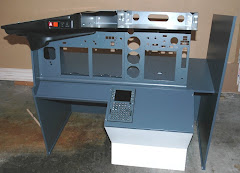I'll resist "cracking" another dumb joke like the "yolk" is on me..
The yoke is finished and awaits mounting in the new base. More construction notes for you. First off, I added a couple of terminal blocks inside the yoke for the roll potentiometer and the other switches on the yoke handle:
In the base I needed to beef up the stops I had in there to limit the travel of the column to 10 degrees forward and back. I used some cut down blocks of 2X4 that are long enough to push up against the ends of the base. More on that in a moment. What I want to show in the next photo is the mounting plate for the elevator potentiometer. I re-used the mount from the CH Products yoke, since I can use the trim tab to fine tune the calibration of the potentiometer. It's the little lever you see in the photo. With this you can adjust the offset of the potentiometer, important since it's range of usefulness is quite narrow, more so than the pot on the roll control. I screwed the mounting plate onto a scrap of plastic, to make it easier to move it up and down the wooden stop that you see here:
Note the adjustable end stop on the wooden block. This allows fine tuning to ensure that the control column travel is within specs. Next photo shows the block in the base with the potentiometer hooked up. Note the metal rod that is connected to the column base and then to the lever on the pot:
Now we need to wire it all up to the control board. It's on the other (forward) side of the base, mounted on top of the stop block. You can also see the 2 cat 5 cables coming out of a hole drilled in the bottom of the column. There's not a lot of travel and despite the seeming mess of wires, nothing tangles up on anything.
Eagle eyes will notice a couple of switched thrown in behind the control board. These micro switches are from the old yoke base. I may have a use for them later, in the meanwhile I've just tucked them in here since they're wired up to everything else. The old throttle, mix and trim potentiometers that were also in the base were connected via a quick connect on the board. It seems to work fine without them so I've disconnected them completley. I may have use for them in the future - we'll see.Now to test and fine tune the calibration. When I first hooked it up the roll worked fine, as did all of the switches on the yoke. Unbelievable! As far as my computer and FSX was concerned, I'd just plugged in a CH Products yoke. What didn't seem to be working was the elevator potentiometer. This is where the calibration comes in.
You can get to the calibration a couple of ways. In these examples I launched the CH Products calibration software from within FSX:
What we're looking for is movement on the Y axis, that's the little dot in the square box on the left. If you don't see any movement (or limited movement) in this box, move the adjusting lever on the CH Products mounting plate (as shown in the 3rd photo above) until you can see the full range of travel. With the column full forward, the dot should be at the top:
Full back the dot should be at the bottom:
Dot doesn't cover the complete distance? You'll need to adjust how far up or down the connecting rod is on the potentiometer lever.Bottom line: this thing works and it's cheap. It also means I don't need to order any more gear from bolshy Europeans...
Talking of which, I received some new software from our good friends at Revolution Simproducts. I'm happy to report that the flaps and spoiler levers are now working. Still a bunch of other things that aren't but I'm sure that in another month or so, we'll get it all working....
Also heard from CP Flight, my new units and replacement MIP card are on the way. Hurrah!













No comments:
Post a Comment